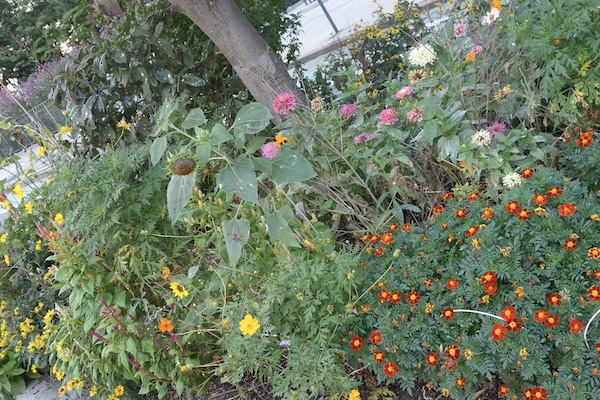
TEXT AND PHOTOS BY DEBORAH FENKER | The work of a gardener never ends, nor does the joy it imparts to the beholder. But that work is always at the mercy of Mother Nature as well as the inexplicable extremes of human behavior. Thus is the struggle of the Chelsea Garden Club, whose members have diligently adopted and maintained tree pits on the pedestrian medians of West Chelsea. And while this summer’s annual Tree Pit Walking Tour (chronicled in years past here and here and here) was cancelled by Nature—excessive heat—there was still much beauty to behold a few weeks ago, when Chelsea Community News was granted our request to highlight the Garden Club’s work by seeing that Tree Pit Walking Tour through.
Note: To follow Chelsea Garden Club on Facebook, click here. To contact them via email, click here.
We began our tour on West 29th Street and Ninth Avenue, guided by knowledgeable Chelsea Garden Club member Milt. This tree pit, planted and maintained by Sharon Lynch, is befittingly anchored by a sizeable Rose of Sharon, a beautiful pale pink hybrid flanked by tufts of alyssum and a vibrant purple butterfly bush. Lynch has been crestfallen by this growing season’s unusually high volume of vandalism and disregard for the work that is put into beautifying these tree pits—and unfortunately, she is not alone among the Garden Club membership. But for all its travails, her garden looks pretty great; and if you look closely, you can find a big cluster of grapes fruiting off a vitis vinifera vine nestled within the greenery, a true testament to the stubborn, enduring essence of nature.

Moving south, P.J.’s garden even has a small water feature, a little fountain amongst the Zebrina mallow and Scarlet salvia. She’s also installed a few decorative logs that give a rustic appeal and a nice contrast to the flora.

The West 28th St. and Ninth Ave. gardens are kept by our tour guide Milt—both north and south, which is a big job. But he diligently waters every day, quenching his thirsty zinnias, brown-eyed Susans, and four o’clocks. He’s also paid attention to seasonality, adding goldenrod and asters whose bloom has provided an ongoing splash of color throughout the growing season.

Milt also tends the West 27th St. and Ninth Ave. pit, featuring shocks of yellow from a hardy portulaca groundcover, more zinnias, Stachys, and lofty sunflowers. A beautiful frothy grass borders the south edge, called dog fennel, which is apparently toxic in high doses, although frankly most ornamental plants are. “Don’t tell anyone I have it,” joked Milt, although many indigenous plants are poisonous and you shouldn’t be eating that stuff, anyway. It’s how plants protect themselves, because the gardeners aren’t always there to do it. And bees were buzzing happily around all the surrounding bright blooms, so they weren’t bothered. In fact, there were quite a few bees in most of the gardens, a reassuring sign that apian populations are rebounding.
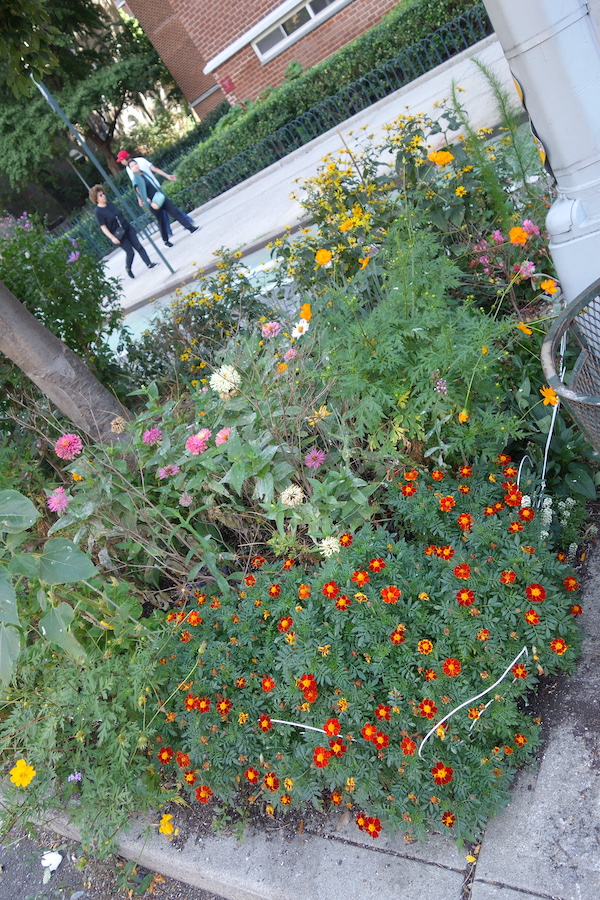
The three gardens from West 26th St. and Ninth Ave. down to West 24th St. are all tended by Luis. His are hallmarked Klondike cosmos, like little sunshines on stems, alongside robust cliome and 4 o’clocks. There might be some redundancy in the gardens, which is mostly because those plants are the ones that thrive under these specific urban conditions, but the plantings also fluctuate immensely depending on the time of year. The West 26th St. and Ninth Ave. garden showcases from a large-canopied elm, but suffers from the shade it casts. Some weedy amaranth and hostas survive, but not much else can grow here, and the gardeners are rethinking the plantings for next season. It does have quite a nice little scalloped, white wire fence around it, for protection.

The garden at West 25th St. & Ninth Ave. north. has a ton of heliopsis, Queen Anne’s lace, and Russian sage.
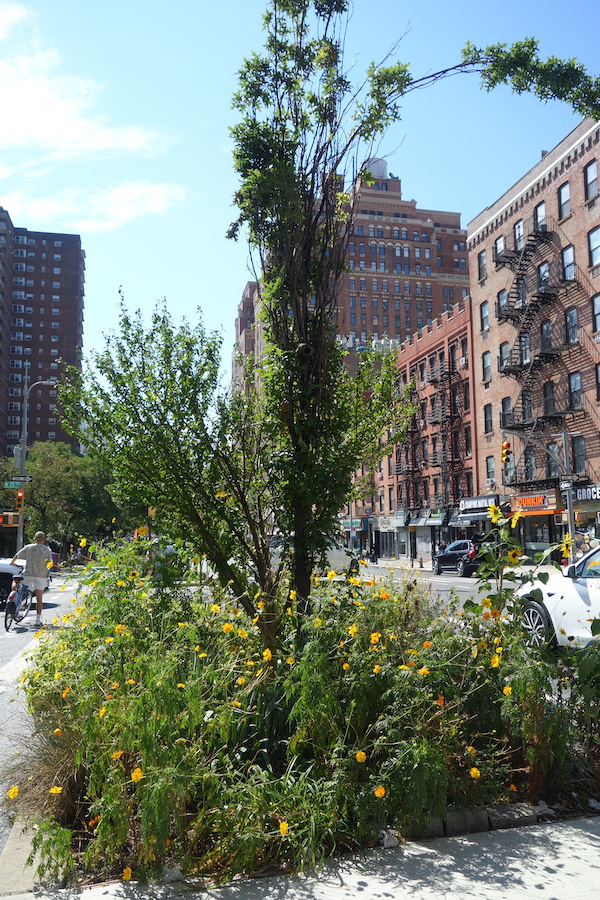
His southernmost plot is rambling melange of majestic sunflowers, violet Verbena Bonariensis, cliome and 4 o’clocks.
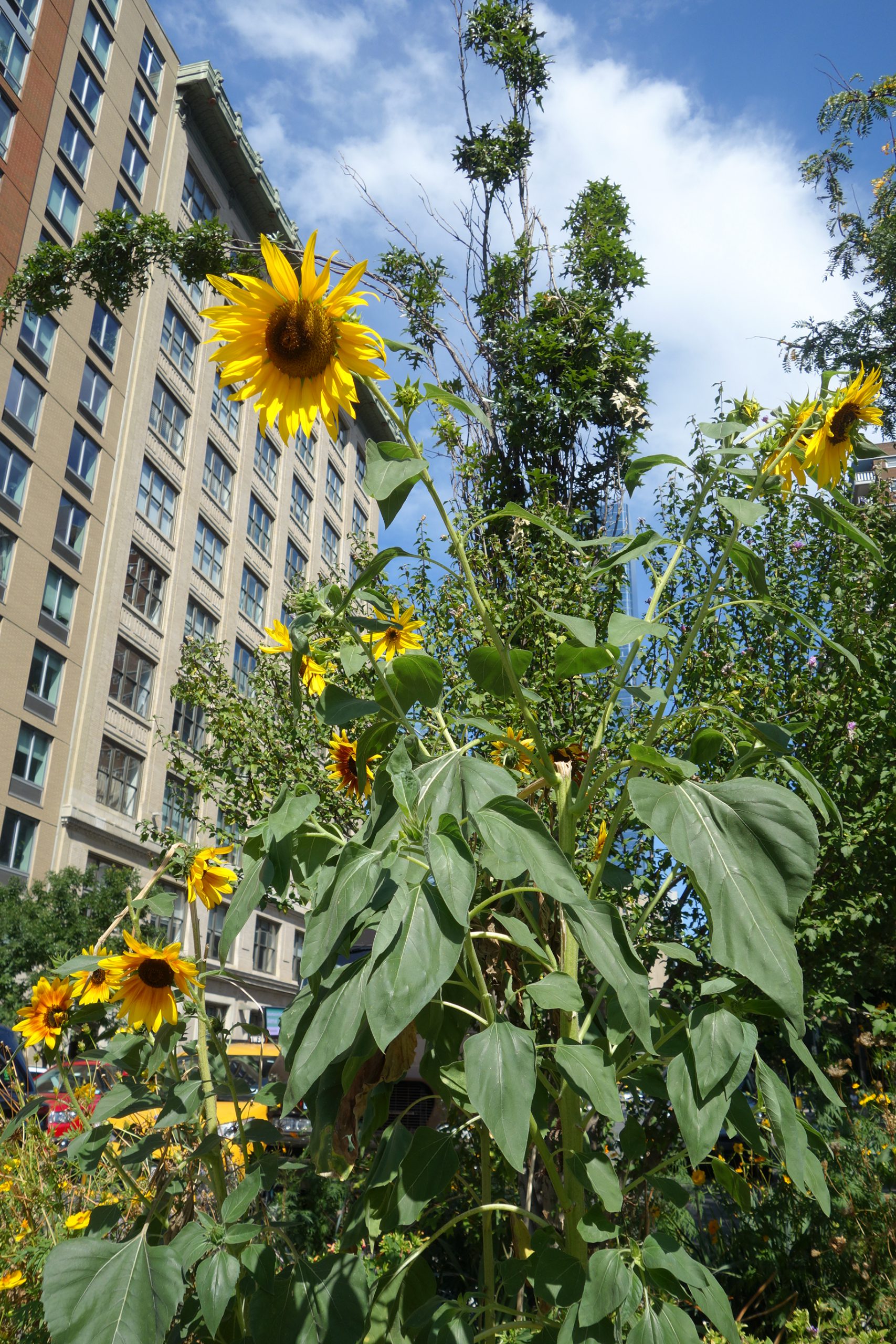
The West 22nd St. and Ninth Ave. garden shows the benefits of teamwork. Diane and Lynn combine their efforts on this one, and it pays off in droves. A well-curated tableau of petunias, more Zebrina mallow, amaranth, and sunflowers are all bedded in an interestingly lush, pale-green sedum groundcover, given texture and preventing water loss. Many of the gardens are centered around a tree, which shades the garden below with its leafy canopy. Here, however, is an ingenious species of pin oak especially bred for its branches to grow nearly vertically, so it remains more conical in shape, like a cypress. This gives the flora below the sunlight it needs to thrive, while providing the air-cleaning oxygen and wildlife benefits of trees.
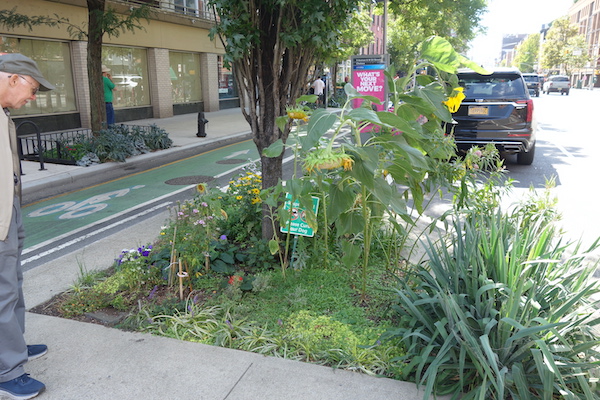
Eric’s garden on the north side of West 21st St. and Ninth Ave. appears to have given nature a bit more leeway—a robust urban jungle with lavender, heliopsis, pink dianthus, and, most intriguingly, the only cactus native to this region, a yellow-flowering prickly pear nestled aside zippy dragonfruit portulaca. The lack of rain in early September wreaked havoc on a lot of the plants, where manual watering wasn’t quite enough to keep them thriving, but these hardy varietals survived.
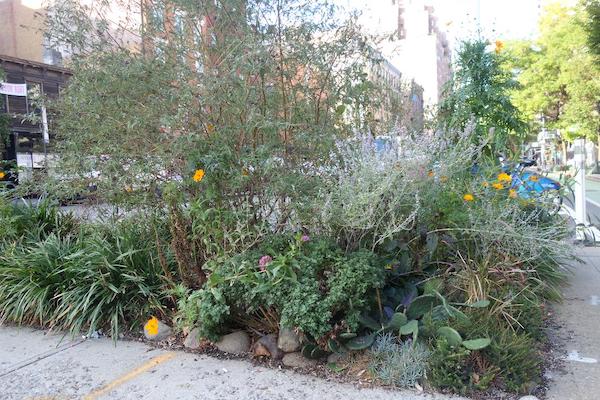
The garden on West 21st St. and Ninth Ave. south (also Eric’s) shows a lot of careful planning. His design ensures blooms throughout the season, a magenta butterfly bush mirroring similarly hued begonias, marigolds, goldenrod, and cosmos for bright, showy yellows and lots of grass variants for different shades of green. Some dusty miller with its powdery pale mint color highlights the flowers vibrancy.
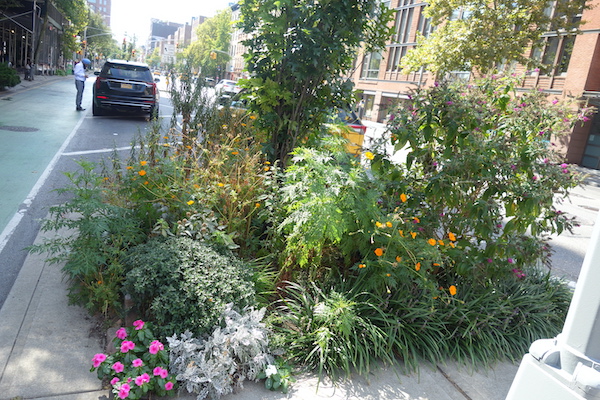
The garden at West 20th St. and Ninth Ave., which its keeper, Missy, dubs a “scent garden,” is resplendent with frolics of roses (in season), sweet alyssum, and mulberry, dominated by hardy chrysanthemums and 4 o’clocks come fall. She gets a lot of sun, so irises and lilies do well earlier in the year, but they are long gone by now. She has also installed a covetable little bench on her premises, and people do take advantage of it frequently, just to take a brief respite or enjoy her plantings.
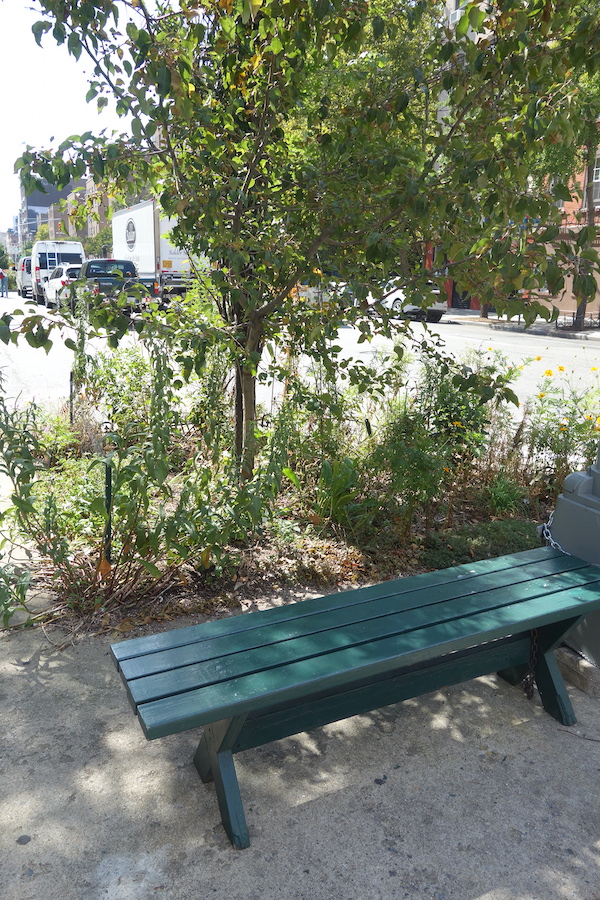
Her garden on West 19th St. and Ninth Ave. is mostly roses, with some hardier 4 o’clocks thrown in for good measure. Roses take a lot of care and grooming, but their thorny stems are good at fending off trespassers.
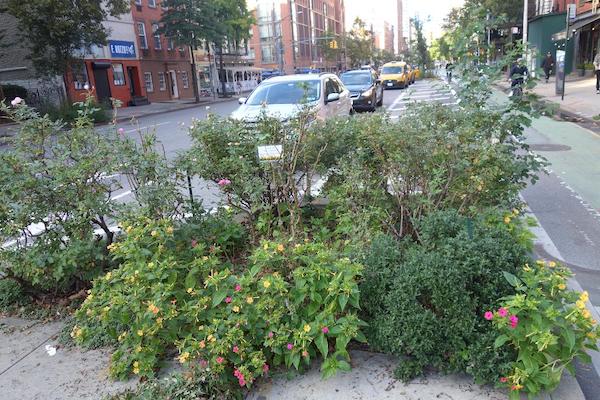
West 18th St. and Ninth Ave. features more sage and aster, but has suffered much vandalism and has at times been treated as a trash disposal. This type of abuse is tragically unenforceable, as it is rarely caught in-the-act, but is disheartening to the nonetheless determined gardeners who put so much time, energy, money, resources, and love into maintaining the gardens. Any initiative to deter the destruction that so many of these gardens incur would be met with open arms.
One garden that has almost made itself impervious to such desultory attacks is Chris Toto’s resplendent oasis on West 18th St. and Eighth Ave., both north and south sides. The splendor of, and attention to, such a well-maintained plot certainly seems to deter at least some of the ne’er-do-wells. He also implements a stone barrier which he built himself and spiky blue dune lyme grass which might poke an unwelcome invader.

His pride and glory is the north garden, however, with spectacular sunflowers, sunny coreposis, yellow-centered purple asters, scarlet salvia and a plethora of multi-hued zinnias.

West 19th St. and Eighth Ave. has a lovely, undulating rock detail, dividing some nicely mulched turf from a lush expanse of groundcover, some spiky asters and sunflowers already nodding their heads to fall.
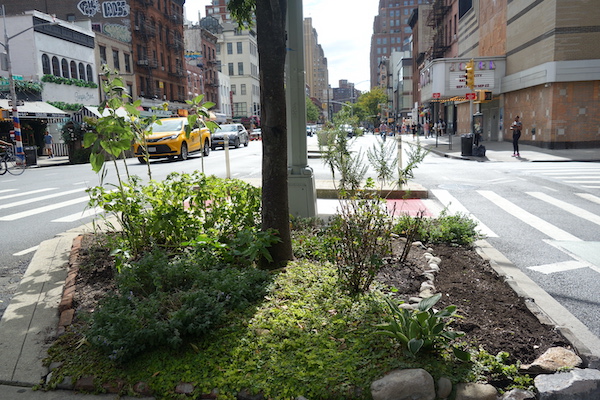
Finally, West 22nd St. and Eighth Ave. is a display of simplicity: Yellow cosmos are still flourishing, contrasted nicely with more blue lyme dune grass. There was a charming, well-maintained plot on West 23d St. and Eighth Ave. that was repeatedly assaulted, and fell into disrepair. It is now a victim of construction, as well, cordoned off by the city with unsightly orange netting twisty-tied onto the white wire fencing that has also been uprooted and bent out of shape.
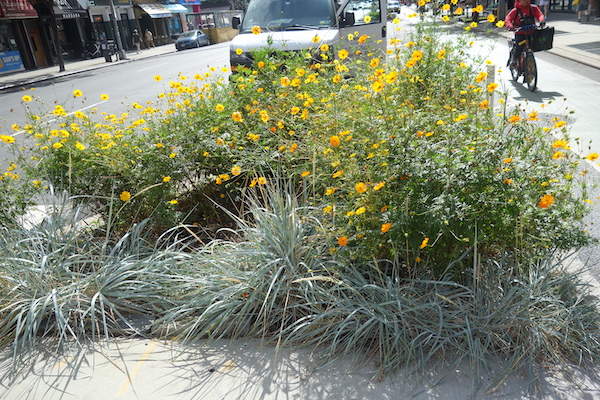
The gardeners are a tough lot. Many of them schlep buckets of water from their own sources; the luckier ones have access to hydrants. Some are out daily removing trash and detritus from their little oases, much of which could be avoided if people were just a little more conscientious and respectful of their very hard work. The displays improve the visuals of the neighborhood, support pollinators, and even add a little boost of oxygen. It’s not too much to ask for people to just not make the gardeners’ job any more difficult than it already is.
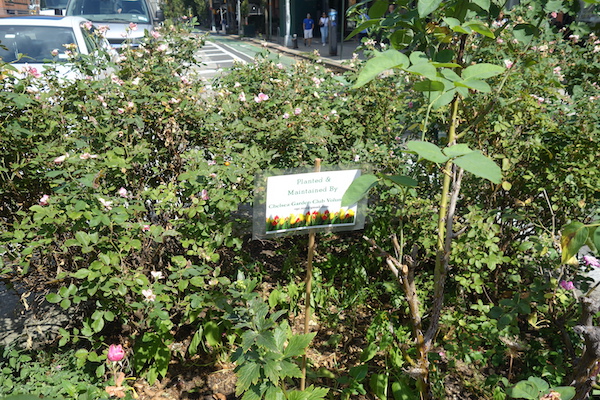
To follow Chelsea Garden Club on Facebook, click here. To contact them via email, click here.
—END—
ChelseaCommunityNews.com (CCNews) is an independent, single-owner online newspaper providing news, arts, events, and opinion content to Manhattan’s Chelsea community and its adjacent areas (Flatiron/NoMad and Meatpacking Districts, Hudson Yards, Hell’s Kitchen, Broadway/Times Square, and the Penn Station area). Our editorial content is made possible by advertising revenue, grants, quarterly pledges of support, and voluntary reader donations (click here for our GoFundMe campaign). To join our subscriber list, click here to receive ENewsletters containing links to recently published content–as well as an occasional “Sponsored Content” email featuring an advertiser’s exclusive message.
ChelseaCommunityNews.com is a member of the New York Press Association (NYPA) and the Empire State Local News Coalition. Our content is collected for placement in the United States Library of Congress’ LGBTQ+ Studies Web Archive. (“We consider your website to be an important part of the historical record,” read a July 26, 2019 email.) Our freelance reporters have been recognized by NYPA’s annual Better Newspaper Contest, with Honorable Mention wins for Best News or Feature Series (2021 & 2023). CCNews is a three-time winner in the Coverage of the Arts category (First Place and Honorable Mention, 2022 and Third Place, 2023).
PLEASE SUPPORT LOCAL JOURNALISM: HELP CHELSEA COMMUNITY NEWS THRIVE BY FREQUENTLY VISITING THIS WEBSITE TO READ OUR ARTICLES AND CLICK ON THE ADVERTISEMENTS.
Questions? Comments? Want to Place an Advertisement or Make a Donation? Email Founder/Editor Scott Stiffler at scott@chelseacommunitynews.com.

Pingback: This Week In & Around Chelsea: March 17-23, 2025 - Chelsea Community News
Pingback: This Week In & Around Chelsea: March 10-16, 2025 - Chelsea Community News